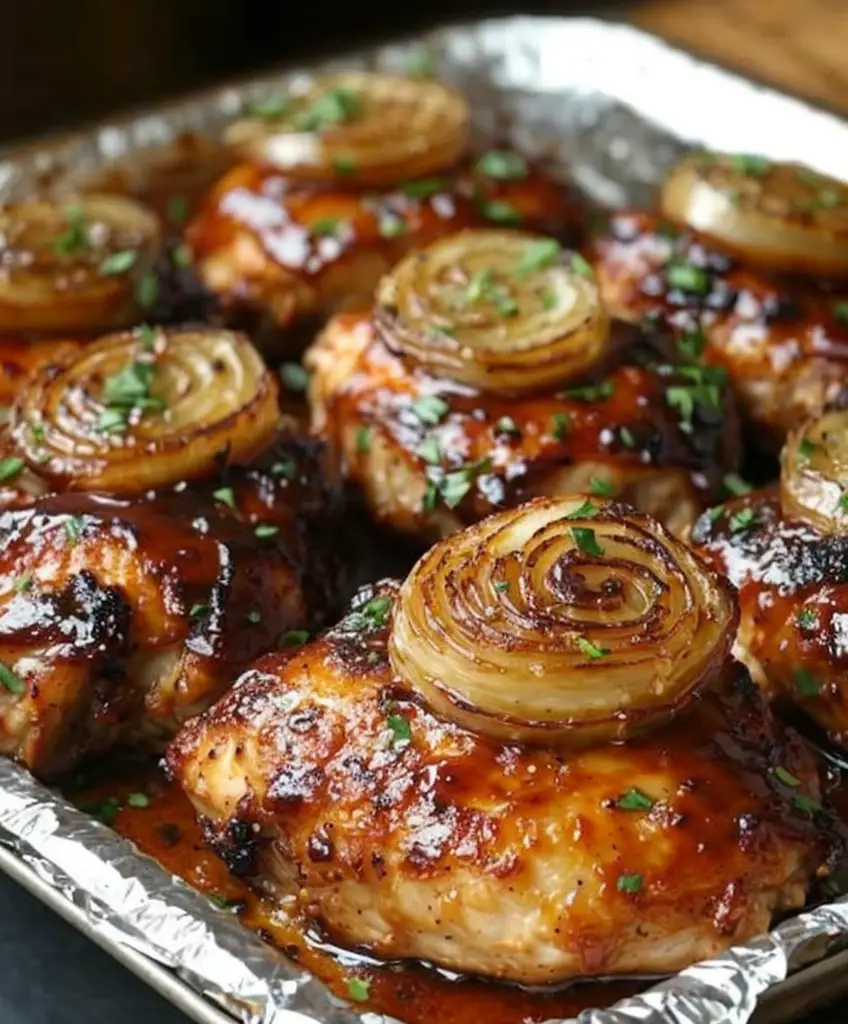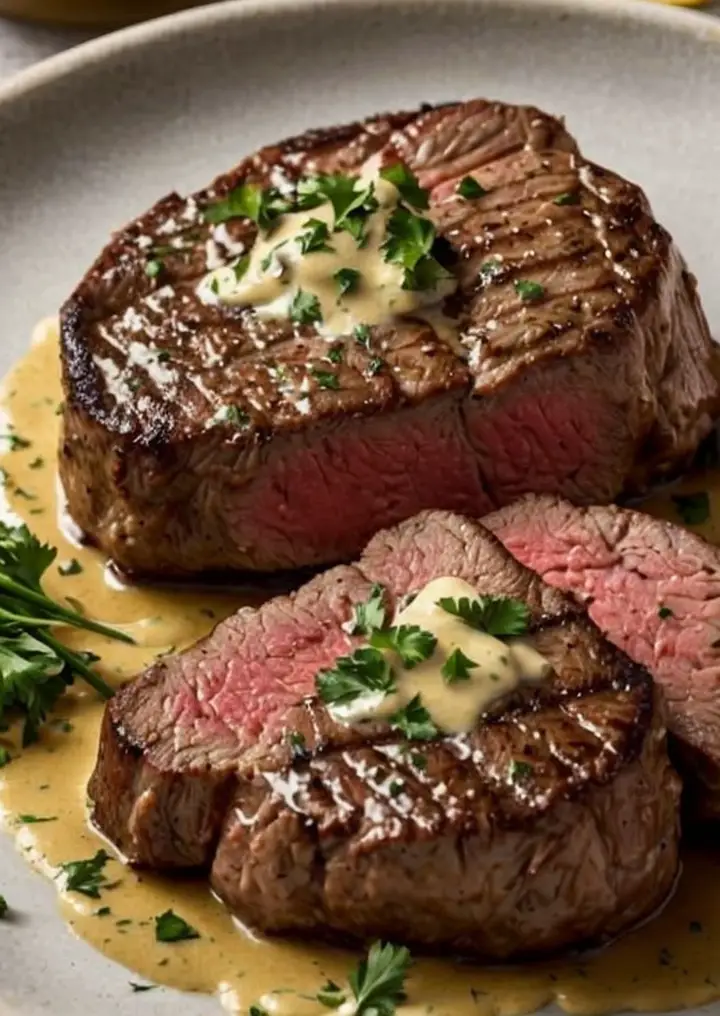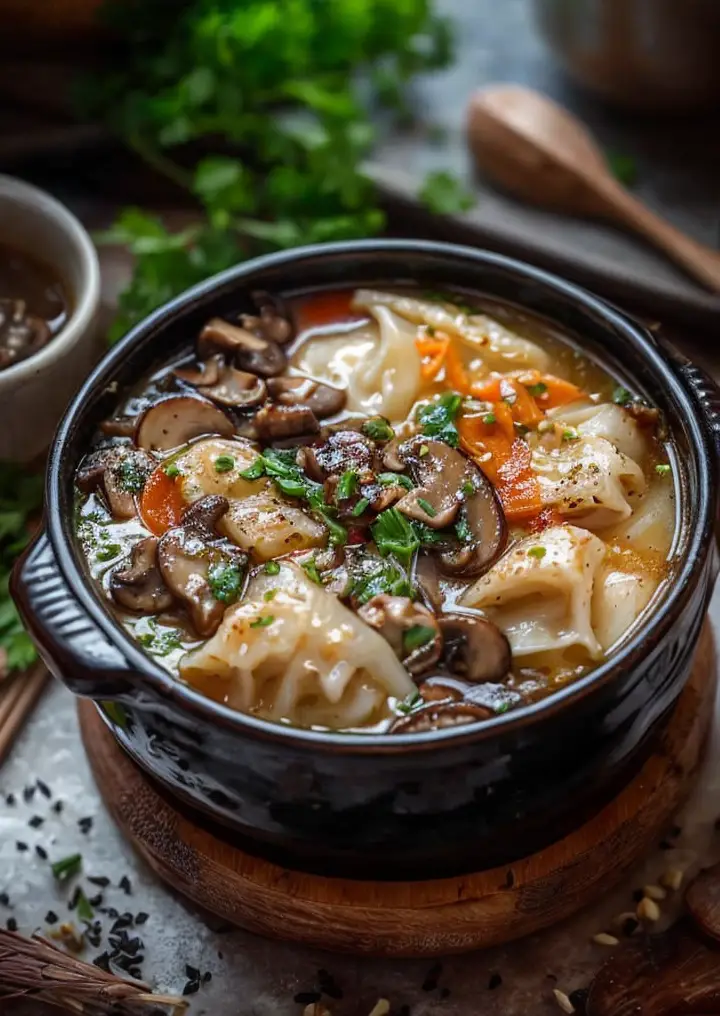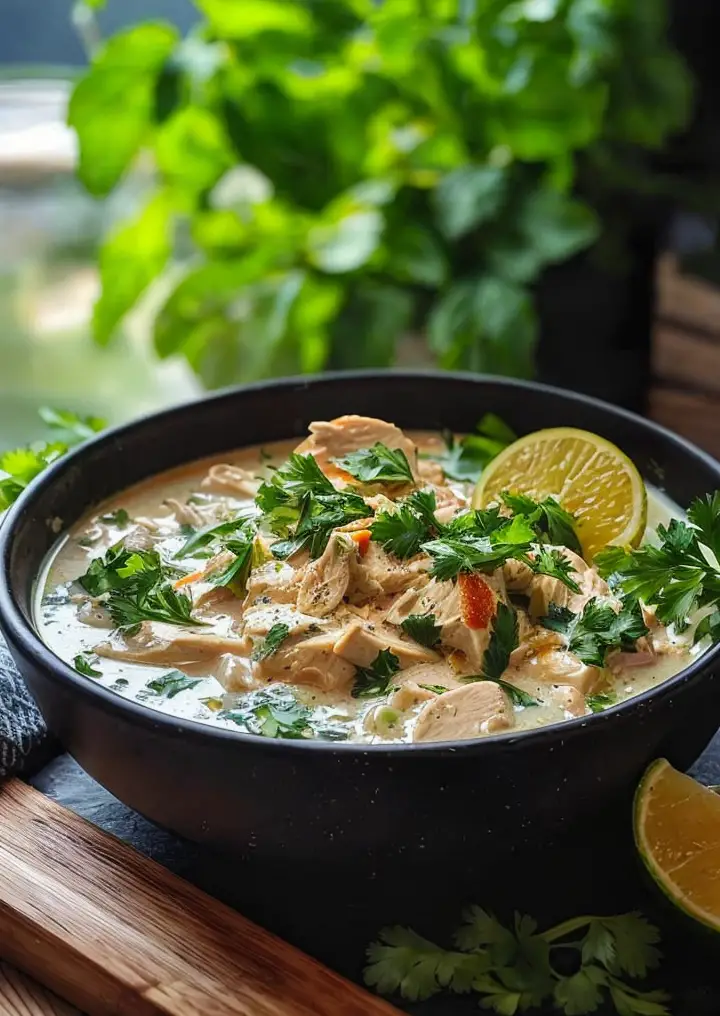Baked Barbecue Chicken Thighs with Caramelized Onions: The Ultimate Comfort Meal
Baked Barbecue Chicken Thighs with Caramelized Onions is more than just a meal; it’s a celebration of flavors and comfort food at its finest. The juicy, tender chicken thighs baked to perfection bathed in rich, smoky barbecue sauce complement the sweet, buttery caramelized onions beautifully. Imagine gathering around the dinner table with your loved ones, the aroma of this delicious dish wafting through the air, creating an inviting atmosphere that entices everyone to dig in. This recipe promises not only a feast for the palate but also an experience that warms the heart.
The combination of succulent chicken and sweet onions creates a symphony of tastes that dances on your tongue. With each bite, expect a burst of savory barbecue paired with the melt-in-your-mouth texture of caramelized onions. This dish is perfect for casual family dinners or when entertaining friends at a barbecue. Its eye-catching presentation makes it a showstopper, while the ease of preparation leaves you plenty of time to enjoy the company of your guests.
Quick Recipe Highlights
- Flavor Profile: Smoky barbecue meets the sweetness of caramelized onions for a perfect harmony of flavors.
- Texture: Juicy chicken with a crispy exterior, contrasted by the soft, caramelized onions.
- Aroma: Enticing aromas of barbecue and sweet onions blend beautifully as they cook.
- Visual Appeal: A plate brimming with vibrant chicken thighs and golden onions, creating an inviting centerpiece.
- Skill Level Needed: Perfect for novice cooks but delicious enough for seasoned chefs.
- Special Equipment: Just a baking dish and a good knife for slicing onions.
Recipe Overview
- Difficulty Level: This recipe is easy to follow, even for beginners in the kitchen. It involves simple cooking techniques that yield delicious results.
- Category: Ideal for dinner, this recipe fits beautifully into casual family meals or friend gatherings.
- Cuisine: Inspired by classic Southern barbecue flavors, combining elements from American culinary traditions.
- Cost: Budget-friendly, as chicken thighs and onions are both affordable, making this dish accessible for all.
- Season: Perfect for year-round enjoyment, but particularly satisfying in the warmer months when barbecues are plentiful.
- Occasion: Great for daily meals or special gatherings like potlucks, family reunions, or summer barbecues.
Why You’ll Love This Recipe
The rich taste and tender texture of Baked Barbecue Chicken Thighs with Caramelized Onions will make it a frequent request at your dinner table. The chicken thighs soak up the barbecue sauce, infusing each bite with a delightful tanginess that contrasts beautifully with the sweet onions. This balance of flavors creates an unforgettable taste that leaves you craving more.
Convenience is key in today’s fast-paced world, and this recipe shines when it comes to ease of preparation. With only a handful of ingredients, you can have a hearty meal ready without spending hours in the kitchen. After a brief prep, your chicken thighs do all the work in the oven, letting you relax or attend to other tasks.
Nutritionally, chicken thighs are a great source of protein and essential nutrients. Paired with onions, which provide antioxidants and fiber, this dish is not only filling but also nourishing. Serve this dish guilt-free, knowing you’re indulging in a wholesome meal that supports your health.
This recipe is also perfect for social gatherings. Its inviting aromas and stunning presentation will spark conversation and fill your home with warmth. Share a plate at dinner parties or around the grill during summer outings, creating memorable moments with friends and family alike.
With affordable ingredients and accessible flavors, this dish is perfect for anyone on a budget. Chicken thighs offer excellent value while delivering on taste. Your guests will be none the wiser as they savor the deliciousness of this dish.
Historical Background and Cultural Significance
The origins of barbecue can be traced back to indigenous cooking methods, where meats were slow-cooked over open flames. The practice evolved over centuries, integrating various influences from settlers and immigrants, ultimately shaping the rich barbecue traditions we celebrate today. This dish pays tribute to those foundational techniques, emphasizing the fusion of flavors.
Culturally, barbecue carries deep significance, often serving as a focal point during gatherings and celebrations. Its communal nature encourages togetherness, making it a beloved cooking style worldwide. The act of sharing food, filled with rich traditions, strengthens bonds among friends and family.
Over time, barbecue recipes have evolved across different regions, leading to unique adaptations. From tangy sauces in the Carolinas to the sweet styles of Kansas City, each variation reflects local palates and available ingredients. This dish melds sweet and smoky flavors, capturing a bit of that rich heritage.
Regional variations are plentiful, as each area adds its twist. From the simple barbecue sauce to innovative flavor infusions, there’s a barbecue style to suit every taste bud. Each recipe evolution demonstrates the adaptability of barbecue across different cultures and tastes.
Ingredient Deep Dive
Chicken Thighs: Chicken thighs are flavorful and juicy, being a staple in many cuisines around the world. They are higher in fat compared to chicken breasts, making them richer and more tender, perfect for roasting or baking. When selecting, look for thighs with uniform color and no bruising for the best quality. Store them in the refrigerator for 1-2 days, or freeze for up to six months.
Barbecue Sauce: Barbecue sauce can vary by region, typically featuring sweet and tangy elements. Its roots stretch back to the Caribbean and American South, where various cultures contributed to its diverse flavors. This sauce not only adds flavor but also moisture to the chicken. Opt for a sauce that aligns with your taste preferences, whether sweet or smoky. Homemade versions allow for customization, while store-bought options provide convenience.
Onions: Onions are a vital ingredient in kitchens worldwide, celebrated for their versatility and flavor-enhancing qualities. They are rich in vitamins and minerals, offering health benefits like improved heart health. When selecting, choose firm onions without soft spots. Store them in a cool, dark place for optimal freshness, and avoid refrigeration to prevent sprouting. You can substitute with shallots or leeks for a different flavor profile.
Common Mistakes to Avoid
- Overcooking the Chicken: Monitor the internal temperature to avoid drying out the chicken; aim for 165°F for moist, juicy thighs.
- Using Low-Quality Sauce: A cheap barbecue sauce can lead to bland flavor; opt for a high-quality sauce for the best taste.
- Neglecting to Caramelize Onions Properly: Allow onions to cook slowly to develop their sweetness; rushing this step can result in unpleasant raw flavors.
- Skipping Marination: Marinating the chicken enhances flavor; do not skip this step, even if it’s just for a short time.
- Not Prepping Ingredients First: Preparing ingredients beforehand can smooth the cooking process; take time to chop and measure before cooking.
- Ignoring Cooking Time: Ovens can vary significantly; keep an eye on the food to prevent overcooking or burning.
- Missing Flavor Enhancers: Don’t forget to season well; a bit of salt and pepper can elevate the dish dramatically.
- Skipping the Rest Time: Allow the chicken to rest after cooking; this step retains juices for a more flavorful bite.
Essential Techniques
Caramelizing Onions: Caramelizing onions is crucial for flavor development. Cooking them low and slow allows natural sugars to break down, resulting in sweetness. Avoid high heat to prevent burning, and use a wide pan for even cooking.
Roasting Chicken: Roasting allows for even cooking and flavor enhancement. Start at a high temperature to lock in juices and finish with a lower temperature to ensure thorough cooking. Basting the chicken periodically with sauce can also boost flavor.
Pro Tips for Perfect Baked Barbecue Chicken Thighs
Experiment with different barbecue sauce varieties to find your favorite flavor profile.
Try marinating the chicken overnight for even deeper flavor penetration.
For added crunch, broil the chicken for the last few minutes of cooking.
Consider adding smoked paprika to the barbecue sauce for a deeper, more robust flavor.
Serve with fresh herbs sprinkled on top for a burst of freshness and color.
Accompany this dish with classic sides like coleslaw or cornbread for a complete meal.
Variations and Adaptations
Switching out chicken thighs for drumsticks or breasts can alter the cooking time and flavor.
Seasonal adaptations can include adding fresh herbs or changing the barbecue sauce to complement seasonal flavors.
For dietary modifications, use gluten-free barbecue sauce to accommodate gluten intolerances.
Experiment with different types of onions, such as red or sweet onions, for unique taste variations.
Incorporating fruits like pineapples or peaches in the sauce can provide a delightful sweetness.
For presentation, serve on a bed of greens for an eye-catching effect.
Serving and Presentation Guide
To present your dish beautifully, plate the chicken thighs and spoon caramelized onions generously over the top.
Add a sprinkle of freshly chopped parsley or cilantro for color and aroma.
Serve in vibrant, contrasting dishes that also hold the barbecue sauce to entice presentation.
Temperature is key; serve hot for the best flavors and textures to shine.
Consider portion control by offering individual servings or a family-style platter.
Wine and Beverage Pairing
A fruity red wine, such as Zinfandel or Merlot, pairs beautifully with the smoky flavors of barbecue.
For beer lovers, an amber ale or lager complements the sweetness of the sauce.
If you’re looking for non-alcoholic options, consider iced tea or a sparkling lemonade for brisk refreshment.
Serving at the correct temperature enhances the pairing experience, offering a delightful balance.
Storage and Shelf Life
To store, let the chicken cool before transferring it to airtight containers, where it can last up to three days in the refrigerator.
For extended freshness, freeze portions in vacuum-sealed bags, where they can remain tasty for up to three months.
Always check for signs of spoilage before consuming leftovers, such as an off smell or color variations.
When reheating, aim to bring the chicken back to a minimum internal temperature of 165°F.
Make Ahead Strategies
Prep ingredients the night before, chopping onions and measuring out spices for quicker cooking.
Assemble the dish fully except for cooking, then refrigerate it; this works well for busy evenings.
Ensure to assess quality after thawing if previously frozen, as some textures may change slightly.
Reheat in the oven for the best flavor retention; avoid the microwave when possible.
Scaling Instructions
To halve the recipe, adjust ingredient amounts precisely; timing may decrease slightly but check for doneness.
For larger gatherings, doubling or tripling the recipe works well; use extra large baking sheets or multiple pans.
Adjust cooking times based on the total volume, ensuring even cooking throughout the dish.
When scaling recipes, consider the storage needs for leftovers or any unconsumed amounts.
Nutritional Deep Dive
With a balanced macro breakdown, this dish provides healthy protein from chicken, essential fats, and carbohydrates from the sauce.
Micronutrient analysis shows benefits such as B vitamins and minerals important for health.
Nutritionally, this recipe supports overall wellness, especially as part of a balanced diet.
When portioning, be mindful of serving sizes for better weight management and mindful eating.
Dietary Adaptations
For gluten-free options, select a suitable sauce without cross-contamination risks.
Dairy-free adaptations are straightforward, as this recipe contains no dairy ingredients.
To align with keto and low-carb diets, opt for a lower-carb barbecue sauce version.
Paleo adaptations can focus on organic sauces and whole ingredients without preservatives.
Troubleshooting Guide
For texture issues, avoid high heat during caramelization, as this can lead to undesirable results.
If flavor seems off, revisit seasoning; a pinch of salt or additional herbs can elevate your dish.
For equipment challenges, potholes in oven temperatures can lead to uneven cooking; invest in a reliable thermometer.
Address timing concerns by prepping ingredients beforehand to streamline the cooking process.
Recipe Success Stories
Community feedback often highlights the explosive flavors of this dish, particularly among novice cooks.
Readers have shared their variations, showing endless possibilities for personalization with this recipe.
Many have praised how easy it is to adapt, whether swapping out proteins or spices.
Storytelling through photography tips helps others visualize their success in the kitchen with this dish.
Frequently Asked Questions
Can I use boneless chicken thighs? Yes, boneless chicken thighs can be used, but adjust cooking times since they may cook faster than bone-in thighs.
What type of barbecue sauce is best? Choose a barbecue sauce that suits your taste preferences—sweet, tangy, or spicy—to customize the dish.
Can I bake this dish in advance? Absolutely! You can prepare and assemble the dish a day ahead, then bake when ready to serve.
How do I prevent the chicken from drying out? Keep an eye on the cooking time, and use a meat thermometer to check for doneness at 165°F.
Is this recipe suitable for meal prep? Yes, it’s great for meal prep! Portion out leftovers into containers for easy reheating.
Can I substitute other proteins? Definitely! This recipe works well with pork, beef, or even grilled tofu for a vegetarian option.
How should leftovers be stored? Store in airtight containers in the refrigerator for up to three days, or freeze for longer storage.
What’s a good side dish? Classic sides like cornbread, coleslaw, or grilled vegetables pair beautifully with this dish.
Can I adjust the sweetness of the sauce? Yes, you can add honey or brown sugar for more sweetness, or vinegar for tanginess.
Will the recipe still work without caramelizing the onions? While you can skip caramelizing, it enhances flavor, so we recommend including that step for best results.
Additional Resources
Check out other barbecue recipes, including smoked ribs or grilled vegetables, for more ideas to complement your barbecue experience.
Technique guides for mastering baking and marinating will elevate your cooking skills.
Ingredient information can help you select the freshest products available at your local market.
Equip your kitchen with recommended tools that will make preparation easier and more enjoyable.
Join the Conversation
Share your own photos of this recipe on social media to inspire others in the cooking community.
Engage with fellow cooking enthusiasts by leaving reviews and suggestions in the comments section.
Explore creative adaptations of this dish and see how others enhance their recipes.
The Recipe
Baked Barbecue Chicken Thighs with Caramelized Onions
Serves: 4
Prep Time: 15 mins
Cook Time: 45 mins
Total Time: 60 mins
Kitchen Equipment Needed
- Baking dish
- Knife
- Cutting board
- Skillet
- Meat thermometer
Ingredients
- 4 bone-in chicken thighs
- 1 cup barbecue sauce
- 2 large onions, sliced
- 2 tablespoons olive oil
- Salt and pepper, to taste
Directions
- Preheat your oven to 375°F (190°C).
- In a skillet, heat olive oil over medium heat. Add sliced onions, seasoning with salt. Cook slowly, stirring occasionally until caramelized.
- Season chicken thighs with salt and pepper, then place them in the baking dish. Cover generously with barbecue sauce.
- Add the caramelized onions over the chicken before placing the dish in the oven.
- Bake for 45 minutes, ensuring internal temperature reaches 165°F (75°C).
- Let rest for a few minutes before serving to enhance flavor.
Recipe Notes
- For an extra kick, add hot sauce to the barbecue sauce before coating the chicken.
- You can substitute chicken thighs for drumsticks or breasts if preferred.
- Leftovers can be stored in the refrigerator for up to 3 days and reheated thoroughly.




